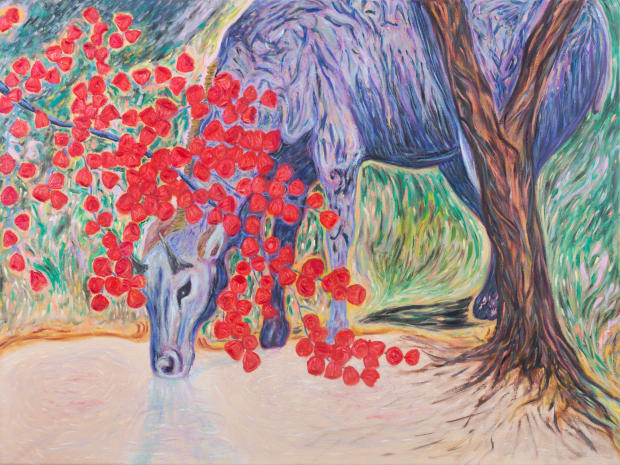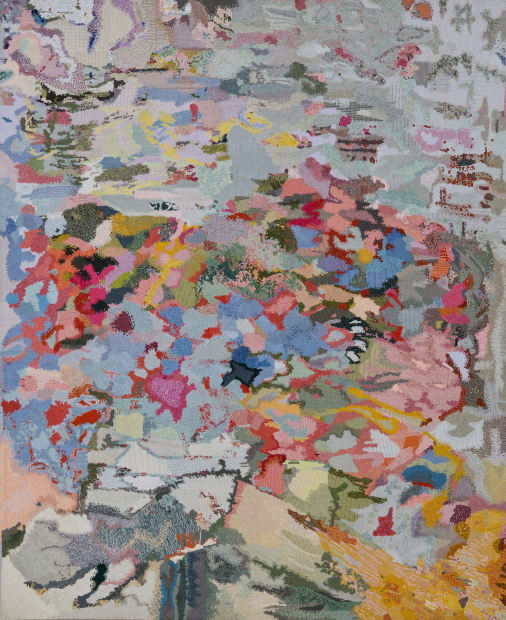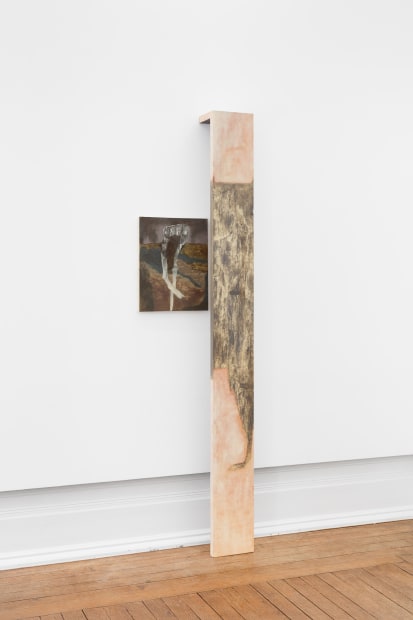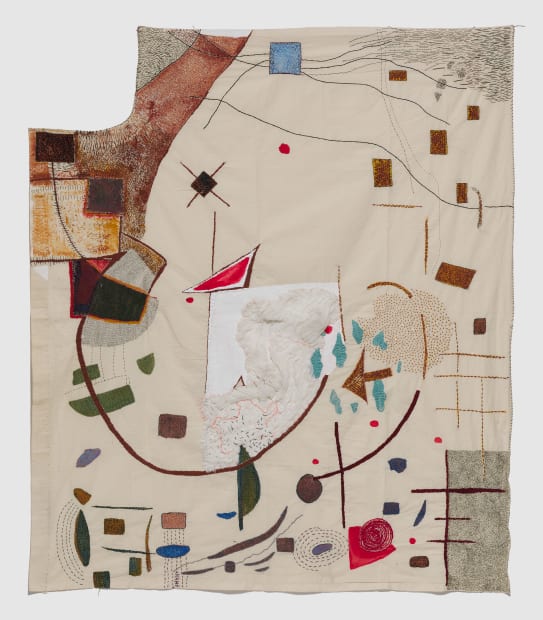-
Experimenter presents a group exhibitions with works by Afrah Shafiq, Ayesha Sultana, Bhasha Chakrabarti, Biraaj Dodiya, Chanakya School, Christopher Kulendran Thomas, Julien Segard, Kaveri Raina, Krishna Reddy, Prabhakar Pachpute, Pushpakanthan Pakkiyarajah, Radhika Khimji, Rathin Barman, Sahil Naik, Sakshi Gupta, Sohrab Hura, Soumya Sankar Bose, T. Vinoja and Vikrant Bhise.
-

-
Kaveri Raina’s acrylic, graphite, and oil pastel paintings on burlap suggest the corporality of a memory, both witnessed and imagined. Abstracted forms rendered from personal experience and inherited histories reveal generations of dislocation. Bodies at rest or in motion oscillate across textured surfaces, interrupted and reimagined mid-story.Densely painted shapes and vigorous swirls of graphite are pulled inwards by their weight in thickness and color. Working from both sides of the burlap’s surface, Raina pushes and pours acrylic through the permeable weave with a rhythmic physicality. Graphite and oil pastel are applied with fervor, forming vortices of promenading ants, spiraling and marching in unison. Burlap weaves of varying rigidity are sewn together, stretched, and often threaded into multiple panels. Shadows appear in layers, echoing the artist’s movements in form and ground. The grit of its structure is bolstered by a deep and unexpected palette, evoking an equivalent response in its reading.
-

-
Prabhakar Pachpute (b. 1986; Sasti, Chandrapur, Maharashtra, India) works in an array of mediums and materials including drawing, light, stop- motion animations, sound, and sculptural forms. His use of charcoal has a direct connection to his subject matter and familial roots, coal mines and coal miners. Pachpute often creates immersive and dramatic environments in his site-specific works, using portraiture and landscape with surrealist tropes to critically tackle issues of mining labour and the effects of mining on the natural and human landscape. Using Maharashtra as a starting point, the artist combines research from around the world and personal experiences, moving from the personal to the global investigating a complexity of historical transformations on an economic, societal and environmental level.Pachpute’s recent works comprise contemplative renditions that have evolved from his earlier conceptual explorations. He delves deeper into his recurring characters and the lively presence of the human, the wild, and the non-human that have shaped his panoramic landscapes over the years. Each piece extends the inquiry beyond material extraction, encompassing the social and psychological dimensions of hardships and systemic abuse. Moving between the local and the global, Pachpute brings an investigative, socio-cultural, ethical, and empathetic lens to his practice, raising critical questions about what it means to be human amid the unfolding crises of our time.What began as a study of altered natural and industrial landscapes has evolved into an exploration of the inner worlds of those affected - revealing how individual experiences and bodies bear the weight of broader power structures. Pachpute now examines these phenomena from the periphery, maintaining a deliberate distance to better understand the complexities, contradictions, and nuances that shape these lived realities.
-
At the centre of Vikrant Bhise’s (b.1984) practice lies the ubiquitous presence of casteism which is entrenched in the social, economic, and political rubric of the nation and its intersectional implications on the movement for land, liberty, and labour. The indefatigable spirit of resistance demonstrated by Dr B.R. Ambedkar, Jyotirao Phule, Savitribai Phule and other anti-caste leaders to uphold the constitutional rights for caste-oppressed communities anchor the core values of Bhise’s works. Through large-scale figurative paintings, Bhise portrays the archival memory of the Ambedkarite movement, personal and intergenerational lived experiences and the daily struggles shaped by caste-based discrimination.
-

-
For much of the past decade, Christopher Kulendran Thomas (b. 1979) has been using advanced technologies across multiple disciplines to question the myths of Western individualism. His paintings metabolize the colonial art history that came to dominate in Sri Lanka after his family, who are Tamil, left escalating ethnic violence there. Kulendran Thomas often exhibits these paintings with video installations that fuse propaganda and counterpropaganda into a speculative vortex of alternate histories.
-

-
Bhasha Chakrabarti (b. 1991) is interested in exploring how artwork, even when grounded in local materials and symbols, can speak to issues beyond the local by situating her practice within global conversations around race, gender, and power. By crossing many genres, she explores art-making as a mode of discourse and her work generates dialogues between subaltern tropes and feminine forms of labor from the global South and the agendas of resistance movements of marginalized communities in the global North.Done from life, these small encaustic paintings were made while discussing psychoanalysis, shame, and mothers. Upon seeing the studies, the sitter’s first reaction was: “I hope I get stitched back together in the right directions!”There’s a longstanding tradition of painting the sleeping nude woman in Western art history which uses a deliberately predatory and objectifying gaze. But when Zeina spoke to Bhasha about “dreams” as liberating fantasies and enactments of desire, she began to wonder if these sleeping subjects could have been resisting their beholders all along through the act of dreaming. What does the odalisque dream about?
-
Ayesha Sultana’s graphite drawings signify a delicate yet intriguing dissonance between appearance and reality, revelation and ambiguity—through configurations and arrangements of geometric shapes and spatial structures, in a frame-by-frame progression of image and time. On closer viewing, the smooth surface of the paper is dark but reflective, nestled within it lies an intricate mesh of frictions and ruptures which animate the tactile surface resembling the texture of metal; thus underscoring the mineral attributes of graphite. This also refers to an element of three-dimensionality produced by the dialogue between the versatile malleability of paper and the austere physicality of graphite.
-

-
Julien Segard (b. 1980; Marseille, France) carefully considers the urban environment, the crevices where the constructed meets the natural, and how the two become inseparable. His works feature an assemblage of found elements and architectural structures that exist because of humans, but are bereft of human presence. The intimate, symbiotic, and oftentimes destructive relationship between man, nature and architecture become points of introspection for Segard in his works. Rooted in experiences of solitude and silence, Segard’s practice immerses the viewer in the minuteness of their elements while simultaneously operating as the entry points into vast infinite spaces.
-
Rathin Barman’s (b. 1981, Tripura, India) examines the nuances of the modern built environment as a tool for understanding socio-political history. Architecture is characteristically perceived as a fixed entity, central to validating history yet simultaneously existing outside it. To Barman, however, architectural form has also served as an anthropological tool, in building a collective recollection of a place and its people. For over a decade, Barman, trained as an engineer and then a sculptor, has been working on understanding urban sprawl and how the built environment and architecture adapt itself to a growing influx of people over extended periods of time. He sculpts with the materials of modern construction: wood, concrete, rebar, silicon, and firebrick, often in combination. Barman also references architectural renderings, in-depth interviews, photographs, and anecdotal reconstructions in his practice.
-
Employing a range of processes that are central to her works, including photographic transfers from personal archives, collage, painting, stitching and drawing, Radhika Khimji (b. 1979) pushes the edges of her practice. Khimji’s ongoing interests in expanding the possibilities of thinking through shapes, geometry, and the body in relation to landscapes are often the point of departure in the works on view. Abstracted landscape forms and images from construction sites seem ensconced within innumerable repeated dots and oblong shapes, an act that makes the surface of her works tactile and acutely textured.
-
Sahil Naik’s (b. 1991) Fever Dream explores fragments of murals that adorn colonial and religious architecture across Goa, Gujarat, the Malabar, Macau, and Manila. These images of distant landscapes, flora, and fauna were executed by those who never travelled, but constructed these based on stories and verbal descriptions. Not essentially accurate, but imaginative and localized, including extracts from the 17th century murals from the convent of Santa Monica in Old Goa. Naik is interested in the transplanting of image, architecture and natural history and the situational ‘new’ this contamination produces. Here the ananas (pineapple) and the breadfruit sit aside cashew and the African doum palm, all of which also made their way as embroidered motifs on albs worn by priests and other religious textiles.
-

-

-

-
Considered as one of the most influential printmakers and pedagogues of his generation, Krishna Reddy (1925 – 2018; born in Nandanoor, India, lived and worked in New York, USA) consistently experimented with form, technique and application. In the early 1950’s at Stanley William Hayter’s Atelier 17, he developed and invented the process that he is most well-known for—simultaneous multicolour viscosity printing—and broke new ground in intaglio printmaking. In collaboration with Hayter, Reddy developed the technique in multi-colour printing by utilising variable viscosities of the printing inks.The prints from Krishna Reddy’s The Great Clown series epitomises Reddy’s exploration of new grounds in intaglio colour printmaking through the simultaneous multicolour viscosity process and his interest in the abstracted form of the performing clown. This printing process brings out a motif suspended in a moment of dynamic movement yet contained within a matrix of linear and concentric circles. Reddy’s work also encapsulates the dramatic transition in moods through colour the intricacies in the shifting planes of form, space and time in the performative act of the clown. Rooted in Reddy’s discerning observations of the environment, the The Great Clown series traces the diverse trajectories of his lifelong pursuit to understand form as well as the alienation experienced by an artist in their creative exigencies.
-
Art Mumbai
Current viewing_room









































